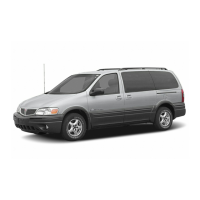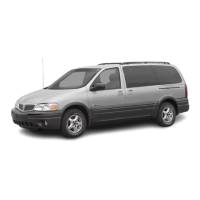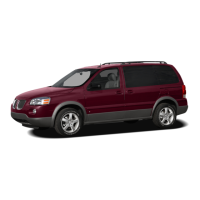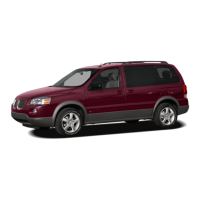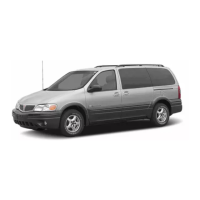
Do you have a question about the Pontiac 2003 Montana and is the answer not in the manual?
| Brand | Pontiac |
|---|---|
| Model | 2003 Montana |
| Category | Automobile |
| Language | English |
Details on manual and power seat adjustments, including heating and head restraints.
Information on rear seat operation, stowage, and the flip and fold feature.
Guidance on proper safety belt usage for adults and children, including answers to common questions.
Information on child restraint systems, including types and proper installation for different age groups.
Explanation of frontal and side impact air bag systems and their operation during a crash.
Guidelines for checking the proper functioning of safety belts and child restraint systems.
Information on vehicle keys, including remote keyless entry and theft-deterrent systems.
Details on manual and power door locks, including automatic locking and lockout protection features.
Instructions for operating power windows, including express-down and rear quarter windows.
Information on the vehicle's theft-deterrent alarm system and how to arm/disarm it.
Guidance on vehicle break-in, ignition positions, starting the engine, and coolant heater.
Instructions for adjusting manual and power rearview mirrors, including convex and heated options.
Overview of OnStar services, including GPS, wireless communications, and available plans.
Information on the HomeLink transmitter and how to program it for garage door openers.
Details on various storage compartments like glove box, cupholders, and overhead console.
Customizing vehicle features like locks, lighting, and door operations through programming modes.
Identification of main instrument panel components like outlets, levers, and indicators.
Explanation of the hazard warning flashers and their function.
Information on how to use the vehicle's horn.
Instructions on how to adjust the steering wheel for comfort and access.
Details on using the turn signals, headlamp controls, and wipers via the multifunction lever.
Operation of exterior lighting controls, including automatic headlamps and fog lamps.
Controls for instrument panel brightness and interior lighting, including entry and delayed lighting.
Guidance on operating the heating, cooling, and ventilation system for optimal comfort.
Explanation of various warning lights, gages, and indicators on the instrument panel.
Information on messages displayed by the vehicle's message center for warnings and maintenance.
How to use the Driver Information Center for vehicle data, compass, and trip computer functions.
Advice on defensive driving, handling alcohol, and vehicle control basics.
Explanation of braking action, reaction time, stopping distances, and anti-lock brake systems.
Information on the traction control system, its warning light, and operation in slippery conditions.
Details on how the AWD system operates automatically and its features.
Guidance on power steering assist and tips for driving safely on curves.
Instructions on how to recover the vehicle if wheels drop off the road edge.
Tips for safely passing other vehicles on two-lane highways.
Understanding what causes loss of vehicle control and how to react in emergencies.
Information on the three types of skids and how to handle them.
Tips for safer night driving, including visibility and driver impairment awareness.
Advice for driving safely in rain and wet conditions, including visibility and traction.
Explanation of hydroplaning and how to avoid it by slowing down.
Precautions for driving through deep puddles or standing water to prevent engine damage.
Safety advice for driving through flowing water, emphasizing caution due to strong forces.
Tips for increasing safety in city driving, including navigation and traffic signal awareness.
Guidelines for safe freeway driving, including merging, speed, and lane changes.
Checklist for preparing the vehicle and the driver for a long trip.
Awareness and tips to prevent drowsiness or fatigue while driving on highways.
Advice for driving on steep hills and mountains, including vehicle condition and lane discipline.
Tips for winter driving, including vehicle preparation and driving on snow or ice.
Instructions on how to free the vehicle when stuck, including the 'rocking' method.
General considerations and types of recreational vehicle towing.
Information on trailer weight capacity and factors affecting safe towing.
Importance of correct hitch equipment and rules for installation and use.
Guidelines for attaching safety chains between the vehicle and trailer for secure connection.
Requirements for trailer brakes based on weight and proper system integration.
Tips for safe driving with a trailer, including visibility and following distance.
Techniques for safely backing up a trailer with one-handed steering.
Advice on making wider turns when trailering to avoid vehicle contact and ensure safety.
Guidance on driving downhill and uphill, including gear selection and speed control.
Information on obtaining service from dealerships and using genuine GM parts.
Guidelines for performing vehicle service, including using service manuals and safety precautions.
Details on recommended fuel, gasoline octane, specifications, and additives.
Instructions for checking engine components like hood release and electric fans.
Diagram and identification of key engine compartment components.
Information on checking engine oil level, adding oil, and oil type recommendations.
Details on the DEX-COOL engine coolant, its mixture, and protection properties.
Importance of the radiator cap for preventing coolant loss and engine overheating.
What to do if the engine overheats, including operating modes and potential damage.
Overview of the cooling system components and checks, including fan operation and coolant level.
Instructions on checking and adding power steering fluid, including what type to use.
Guidance on using and adding windshield washer fluid, including freeze protection.
Information on brake fluid type, reservoir location, and potential issues.
How to identify worn brake pads and drums, and the importance of proper replacement parts.
Lubricant checks for AWD systems, including transfer case and differential.
Instructions for replacing various vehicle bulbs, including headlamps and taillamps.
Procedure for removing and replacing windshield wiper blades.
General information on tires, including maintenance, safety warnings, and replacement advice.
How to check tire pressure, including the compact spare, and the importance of proper inflation.
Guidance on tire rotation, alignment checks, and when to consider new tires.
Indicators for determining when tires need replacement due to wear or damage.
Advice on selecting the correct tire size, type, and TPC Spec number for optimal performance.
Explanation of tire grading systems for treadwear, traction, and temperature.
Information on factory alignment and when to check for balance issues.
When and how to replace wheels, including proper torque specifications for wheel nuts.
Safety warning against using used wheels due to potential failure.
Guidelines for using tire chains legally and safely, including proper installation and speed limits.
How to use the vehicle's air inflator for tires and other items, including safety precautions.
Tips on what to expect and do during a tire blowout or slow leak.
Step-by-step instructions on how to safely change a flat tire using the vehicle's jack.
Procedure for removing the spare tire and associated jacking tools from the storage compartment.
Instructions for storing a flat tire in the front-wheel drive vehicle's rear storage area.
Procedure for storing a flat tire in the all-wheel-drive vehicle, noting valve stem orientation.
Information on compact spare tire maintenance, usage limitations, and precautions.
General tips for vehicle appearance care, including cleaning product safety and usage.
Advice on vacuuming and cleaning interior surfaces like vinyl, leather, and plastic.
Guidance on cleaning fabric and carpet, including spot cleaning and stain removal.
Specific cleaning methods for common stains like coffee, vomit, and candy.
Cleaning instructions for vinyl surfaces using mild soap and water.
Proper cleaning methods for leather, including stain removal and avoiding harsh chemicals.
Cleaning the instrument panel top surface with mild soap and water.
Cleaning interior plastic parts with mild soap and water to avoid surface finish damage.
Tips for cleaning glass surfaces, including warnings about abrasive cleaners.
Instructions for removing and washing the built-in child restraint pad.
Proper cleaning and maintenance for safety belts and child restraint harnesses.
How to lubricate weatherstrips for longevity and to prevent sticking or squeaking.
Guidance on washing the vehicle, including soap choice and drying methods.
Cleaning procedures for windshield, backglass, and wiper blades for optimal visibility.
Overview of maintenance requirements and schedule, including owner checks and inspections.
Details on scheduled maintenance services and their recommended intervals.
Services that owners can perform, including checks at each fuel fill and monthly inspections.
Important inspections recommended for the vehicle's systems, to be performed by qualified technicians.
List of recommended fluids and lubricants for vehicle maintenance, including specifications.
A section to record vehicle maintenance history and receipts for warranty purposes.
Information on customer assistance procedures and contact details for resolving concerns.
Steps to follow for resolving customer concerns, starting with dealership management.
Contact information for deaf, hard of hearing, or speech-impaired customers using TTY equipment.
Contact details for Pontiac's Customer Assistance Center for support.
Program details for reimbursement of adaptive equipment and resource information.
Information on the Pontiac Roadside Assistance program, including services and contact number.
Details on the courtesy transportation program and available options during warranty repairs.
How to report vehicle safety defects to NHTSA and General Motors.
How to report vehicle safety defects to Transport Canada and General Motors of Canada.
How to contact General Motors to report vehicle safety defects.
Information on ordering service manuals and other technical publications.





